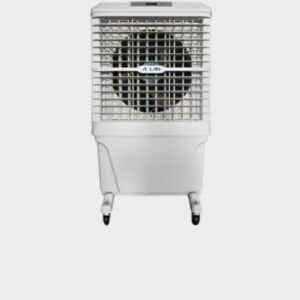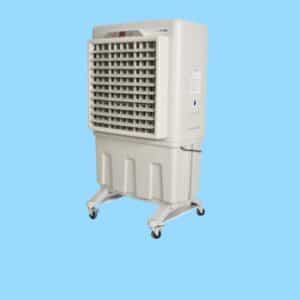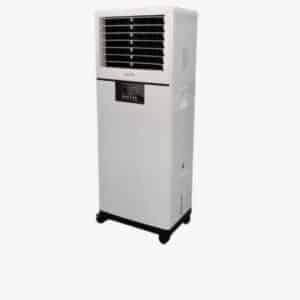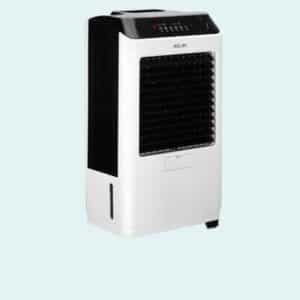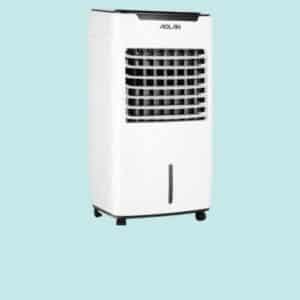As temperatures rise during the summer months, schools across Ireland face a common and growing challenge: keeping classrooms cool, comfortable, and conducive to learning. The problem becomes especially critical during exam season, when students need to concentrate and perform at their best. Traditional air conditioning systems can be expensive to install and run, leading many educational institutions to seek more sustainable, cost-effective solutions. One increasingly popular option is evaporative air cooling—a technology that offers a natural, energy-efficient way to beat the heat.

What Is Evaporative Air Cooling?
Evaporative air coolers work on a simple principle: water evaporation. These units pull warm air through water-saturated pads, causing the water to evaporate and cool the air. The now cooler, moister air is then circulated into the environment.
Unlike conventional air conditioners that use refrigerants and compressors, evaporative coolers consume significantly less electricity and produce no harmful emissions. They are particularly effective in dry or semi-arid climates, but modern models can work well in moderately humid areas, especially in large, open spaces like school classrooms and halls.
The Case for Evaporative Cooling in Schools
Here’s why evaporative air cooling can be a game-changer for schools, especially during the summer exam season:
- Improved Student Concentration and Performance
Heat can have a measurable impact on cognitive performance. Studies have shown that students exposed to high indoor temperatures during exams tend to perform worse than their peers in cooler conditions. Overheating leads to fatigue, dehydration, and a lack of focus, all of which undermine academic performance.
By using evaporative air coolers to maintain a comfortable room temperature, schools can create an environment where students are more alert, focused, and capable of performing to their full potential during high-stakes assessments.
- Energy Efficiency and Lower Operational Costs
One of the most attractive benefits of evaporative air cooling is its low energy consumption. These systems use up to 80% less energy than traditional air conditioners, making them far more affordable to run—an important consideration for schools operating on tight budgets.
In addition to lower utility bills, evaporative coolers also have fewer moving parts than traditional systems, which reduces maintenance costs and extends equipment lifespan.
- Healthier Indoor Air Quality
Evaporative coolers constantly circulate fresh, filtered air from outside rather than recirculating stale indoor air. This can lead to better air quality, with reduced concentrations of indoor pollutants and allergens. For students and staff who suffer from asthma, allergies, or respiratory conditions, this cleaner air can be a noticeable improvement.
Moreover, the added humidity from evaporative cooling can be beneficial in overly dry environments, helping to reduce issues like dry eyes, itchy skin, or throat irritation.
- Eco-Friendly and Sustainable
Schools are increasingly adopting sustainable practices as part of their environmental education and responsibility. Evaporative cooling aligns well with these values. By using water and consuming minimal electricity, these systems produce a much smaller carbon footprint than conventional air conditioning.
Schools that implement evaporative cooling can also use the opportunity to educate students about green technology and the importance of sustainable living—turning the cooling system into a teaching tool.
- Quiet Operation for Better Focus
During exams, a quiet environment is critical. Evaporative coolers generally produce less noise than standard air conditioning units, especially large HVAC systems with heavy compressors. This quiet operation ensures minimal distractions, helping students maintain focus during exams or revision periods.
- Scalable and Flexible Deployment
Evaporative coolers come in a variety of sizes, from small portable units to larger ducted systems. This flexibility makes them ideal for schools, which often have a mix of classrooms, sports halls, libraries, and other spaces with differing cooling needs.
For example, schools can deploy portable units in exam rooms temporarily and move them elsewhere once exams are over. This kind of adaptability is not always possible with fixed air conditioning systems.
Considerations and Limitations
While evaporative cooling offers many benefits, there are a few considerations:
- Climate suitability: These systems work best in dry or moderately humid climates. In very humid areas, their effectiveness can diminish.
- Ventilation: Good airflow is necessary for the system to work optimally. Classrooms should be well-ventilated, with windows or vents open to allow for air circulation.
- Water usage: Though modest, evaporative coolers do use water, so it’s important to factor in access to water and conservation strategies.
As climate change continues to drive up summer temperatures, schools must find smarter ways to manage indoor comfort—especially during exam periods when students are under pressure to perform. Evaporative air cooling offers a compelling solution: it’s affordable, environmentally friendly, and effective in improving comfort and focus.
By adopting this cooling technology, schools can provide a better learning environment, support student performance, and move towards a more sustainable future. Investing in student comfort during exams is not just a matter of physical well-being—it’s a step toward educational equity and academic success.
Coolingsolutions.ie are proud to have the largest selection of evaporative air cooling in Ireland. See our range any time on our website at https://coolingsolutions.ie/ or call John Lawton directly on 087 2078356
-
Coolfresh 12000 Evaporative Air Cooler
€ 1,250.00 Ex. VAT Add to cart -
Coolfresh 6000 Portable Evaporative Air Cooler
€ 750.00 Ex. VAT Add to cart -
Coolfresh 3500 Evaporative Air Cooler
€ 640.00 Ex. VAT Add to cart -
Coolfresh 4500 Evaporative Air Cooler
€ 550.00 Ex. VAT Read more -
Coolfresh 1200 Heater/ Cooler
€ 450.00 Ex. VAT Add to cart -
Coolfresh 1000 Portable Evaporative Air Cooler
€ 425.00 Ex. VAT Add to cart

